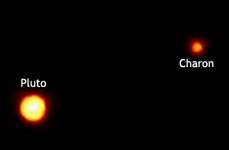
A Hubble Space Telescope image snapped in 1994 easily resolves Pluto and its moon, just 0.9 arcsecond apart. Charon's orbit is about 39,300 kilometers in diameter — but astronomers are surprised that it's not a perfect circle.
Courtesy R. Albrecht (ESA/ESTEC) and NASA.
If David J. Tholen (University of Hawaii) is right, Pluto was probably hit by a small Kuiper Belt object in the not-too-distant past. One consequence of that collision, he argues, is seen in the planet's motion — Pluto and its satellite Charon now waltz around each other in slightly out-of-round orbits. And since tidal forces in the tight planet-moon system should damp out any deviations from purly circular orbits within 10 million years or so, the impact must have occurred relatively recently. "It could have happened a century ago," Tholen says.
The first hints of Charon's slightly odd orbit came during the 1990s, when Tholen and Marc W. Buie (Lowell Observatory) tracked the moon's motion using the Hubble Space Telescope. They found an orbital eccentricity near 0.0075 instead of zero, the expected value. However, due to the great distance involved even HST could not resolve bright and dark patches on Pluto's surface. Consequently, Tholen explains, "We measured Charon's distance to Pluto's center-of-light, not to its center-of-mass."
Luckily, a series of mutual eclipses of the two objects in the late 1980s had enabled Buie to derive a crude albedo map for Pluto, so the effect could be corrected for. But even then a small eccentricity of 0.003 remained — Charon's orbit truly seems to be ever so slightly out of round. If verified, the eccentricity implies an impactor that was many tens of kilometers across, which most likely hit Pluto.
Between April 2001 and April 2002, Tholen used adaptive optics on the 8-meter Gillett (Gemini North) telescope atop Mauna Kea, Hawaii, to repeat the measurements. It's work in progress, he told astronomers this week at the AAS meeting in Seattle, but so far his results are consistent with the earlier findings.
Meanwhile, Buie has reanalyzed the old eclipse observations, and while the resulting albedo map is of higher quality, he doubts that it has "enough credibility to do the calculations right." To try to eliminate the remaining uncertainty, Buie has observed Pluto and Charon repeatedly with Hubble's new Advanced Camera for Surveys (ACS). More data is coming down this spring, and he hopes to complete his analysis by year's end.
As for the cause of the eccentricity, Buie believes a mere close encounter with a Kuiper Belt object would do the trick. "The probability of an impact is very small," he notes. But his observing partner thinks a direct hit is not so far-fetched, statistically speaking, and it might also explain some of the striking brightness variations on Pluto's surface. "Impacts do happen," Tholen stresses, noting Comet Shoemaker-Levy 9's fateful encounter with Jupiter in 1994. "All it takes for this model to work is one event."
 0
0
Comments
You must be logged in to post a comment.